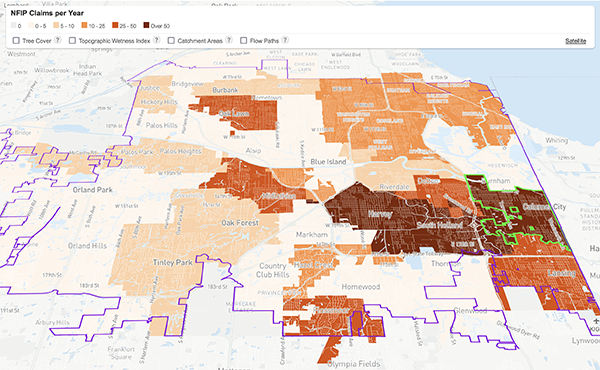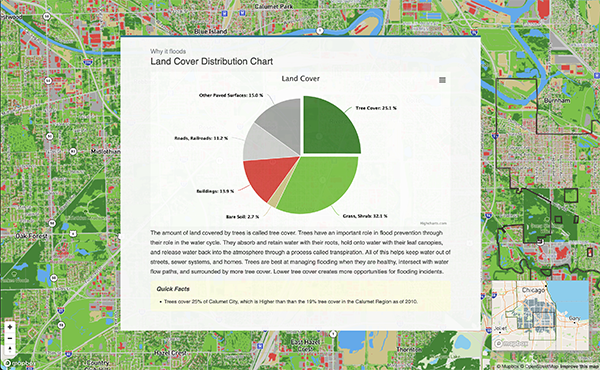Develop Community
Multiple people organized as a group, representing multiple neighborhoods and identities within a municipality, will make a larger impact on elected officials than a single resident on their own. Here’s where you can start:
- Speak with neighbors and other residents about the issue you’ve faced with urban flooding. Are any of them facing the same challenges? What are the commonalities and differences of your experiences? Do you see any patterns among people’s experiences?
- Consider how to grow your group. Can you attend community events to see if others face similar challenges? Can you knock on doors and get a quick poll to see how many people are impacted on the block? What do parents at your children's school say when you talk about it with them? Can you post a flyer at a community center, a respected local business, or at a library to invite folks to join your group?
- Figure out your group’s short- and long-term goals. Who can contribute to those goals and in what ways? What are multiple ways for group members to participate given different schedules and availability?
Community Group Actions
As a community group, your goals and capacity will determine what actions you’ll take.
- Increase the number of supporters
- Develop content (like posters and flyers) to spread news about the issue and get people to learn about your group.
- Post on community social media pages to encourage others with similar concerns to join the community advocacy group.
- Partner with other community groups to reach a broader audience and gather more community input.
- Attend community events to speak about your cause and encourage others to join.
- Identify immediate solutions that homeowners can take and share so people can do something about their urgent concerns.
- Get organized
- Set up meetings to discuss concerns, plans, funding, etc.
- Determine roles or activities that members can participate in.
- Research the issue. Speak with public works officials to learn more about a municipality’s past and current actions to reduce flooding and what evidence they look for. Identify current and historic stormwater management plans by looking at municipal websites, the Metropolitan Water Reclamation District website, in conversation with municipal staff, or through online or library research (search “[municipal name] + stormwater management plans”). Look for any data related to the issue.
- Identify who you need to talk to.You may want to start with your public officials or municipal staff. Or you might reach out to community leaders who do other kinds of work to see if they have any suggestions.
- Develop relationships.Attend public town hall meetings to establish contact with public officials and leaders. Write to elected officials to get them to notice your group.
- Identify opportunities for solutions.Research where local and state funds are being spent. Find your state’s public finance sources: EPA Water Finance Clearinghouse and Funding Sources by State or Territory provided by the Environmental Finance Center Network are great resources.
The Maps & Analysis Section of the Urban Flooding Baseline tool highlight the following actions community advocates could consider pursuing.
- Improving data collection
- Advocate for public engagement of community-identified flooding areas. In communities that do not have community-identified flooding areas or photo data available, local advocates can work with their elected officials and municipal staff to collect data. These data can be used to gain insights into where flooding happens.
- Advocate for improved local data collection to reduce financial and social burdens on communities. Improving local data collection in coordination with federal datasets is an important step to reducing the financial and social burden communities feel in the aftermath of flooding events.
- Encourage local government leaders to participate in FEMA’s National Flood Insurance Program (NFIP) to enhance local flood knowledge. Local governments can improve federal datasets, like Flood Insurance Rate Maps (FIRM), by participating in FEMA’s NFIP program and sharing local knowledge on flooding.
- Solution building
- Consider causes and location of flooding when developing stormwater management plans. Better understanding the factors of flooding and how they vary across the community can lead to the development of more targeted and effective solutions.
- Learn about the locations of land uses in your community. It is important to note the amount of industrial land use in a community and the land uses near industrial areas. Flooding on industrial land may mean that stormwater can carry pollutants to nearby areas, posing potential risks. Solutions for these areas may differ from less pollutant-risk areas.
- Learn about and connect with vulnerable communities in the municipality. Know that there are data limitations to depending on only mapped data when identifying vulnerable communities. The map layers in the community section serve as an introduction to sensitive communities. There are other vulnerable populations to consider, which need to be determined in conversation with residents.
- Advocate for language inclusion for public flooding resources. Ensure that public flooding resources are available in multiple languages so that households are not left stranded.
- Develop community-level solutions by considering how flooding impacts resident lives. Discuss with community members how flooding impacts their lives to include in advocacy work and develop community level solutions to fill the gap in services.
- Community conversations on flooding impacts must be held to accurately represent the community and their concerns. To best understand the impacts of flooding on a specific population, community conversations must be held with a wide representative sample of community residents to make sure that a holistic picture of who is impacted and their concerns are comprehensively collected.
- Partner with other environmental and community advocates to fully understand the multiple burdens the community may be facing. There are likely multiple environmental issues affecting communities that have not been presented on this tool or for which data may not yet be available. Flooding awareness advocates can partner with other environmental and community advocates to learn about the multiple burdens that the community might be facing to develop solutions that provide multiple benefits.
Identifying Your Audience
As your community group gets organized, it’ll be important to know who to talk to in order to make your goals become reality. Below are some suggestions.
- People who control policies
- Municipal elected officials (mayor, council members)
- Alderpeople
- County and State Commissioners
- Contact your state public commission or advocacy and investigative office - representative of state’s public interest; share your advocacy work and ask about possible improvements that can be made.
- Metropolitan Water Reclamation District of Greater Chicago is a great place to start for community members looking to draw attention to their frequent flooding events. The MWRD is a special-purpose district that works to treat wastewater and provide stormwater management for residents and businesses in their service area.
- Potential partners who can provide endorsements
- Regional, public entities like the Forest Preserve, Water Reclamation District, etc.
- Business owners who are also dealing with the consequences of flooding
- Other county governments that might have similar flooding problems or no flooding issues at all - what is their funding like?
Communicating to Your Audience
When reaching out to your elected officials or municipal staff to take action, clearly communicate the answers to the following questions in your letters, public statements, newspaper op-eds, or campaigns.
- What is the issue?
- Example 1: Homes, businesses, and streets within the Calumet region experience severe and repetitive flooding.
- Example 2: Municipalities have varied capacity and funding to implement flood mitigation efforts.
- What is the community ask?
- Example 1: For planning and investment efforts to prevent and mitigate floods in their streets, homes, and businesses.
- It helps to be specific. The specific types of planning, projects, investments, and infrastructure should be informed by community desire. When possible, partner with technical organizations to explain how the community desire fits with a technical understanding of urban flooding.
- Remind decision-makers of the Executive Order 12898 - Federal Actions to Address Environmental Justice in Minority Populations and Low-Income Populations and push for various requests.
- Example 2: The municipality submits a proposal for a grant to fund stormwater management solutions.
- Example 1: For planning and investment efforts to prevent and mitigate floods in their streets, homes, and businesses.
- Who is impacted?
- Example 1: This petition shows the number of homeowners who want something to be done about the flooding in and around their homes.
- Example 2: A map pointing out where the flooding is occurring.
- This is where data can be helpful. Refer to the Urban Flooding Baseline Tool for some data points and work with your community group to improve the data and provide more detailed information.
- Example 3: Data on the vulnerable populations that are impacted by flooding (this can include showing who lives in the flooded area).
- Example 4: Testimonials shared by members of your community group.
Remember to keep in contact with leaders and public officials frequently to keep the issue fresh in their minds. Frame it as an issue of quality of life. When moving to implementation of projects, publicize the project and its supporters.
Community Advocacy Examples and Resources
- RainReady Calumet Corridor
- This resource from CNT shows the result of multiple community engagements towards the creation of six municipal stormwater plans, which are being used as the starting point for $6 million of Cook County American Recovery Plan Act funds to support stormwater management in the Calumet corridor.
- How to Make a Difference Through Grassroots Advocacy
- This resource from CharityVest is a step-by-step guide on how to establish a grassroots advocacy group to enact real-time change.
- FEMA Voluntary and Community-Based Organizations
- This resource from FEMA, Federal Emergency Management Agency, provides helpful information and training on how to operate a community-based advocacy organization.
- Navigate the Flood
- This guide helps local decision-makers as well as city and utility staff navigate the vast and complex array of technical guidance and funding resources for stormwater and flood planning/management. This can be helpful to review when developing advocacy work.
- MPC’s Green Infrastructure Baseline Inventory Data
- This resource from the Metropolitan Planning Council includes a map of green stormwater infrastructure in the Calumet region, which can be helpful to use when solution building for stormwater solutions.



